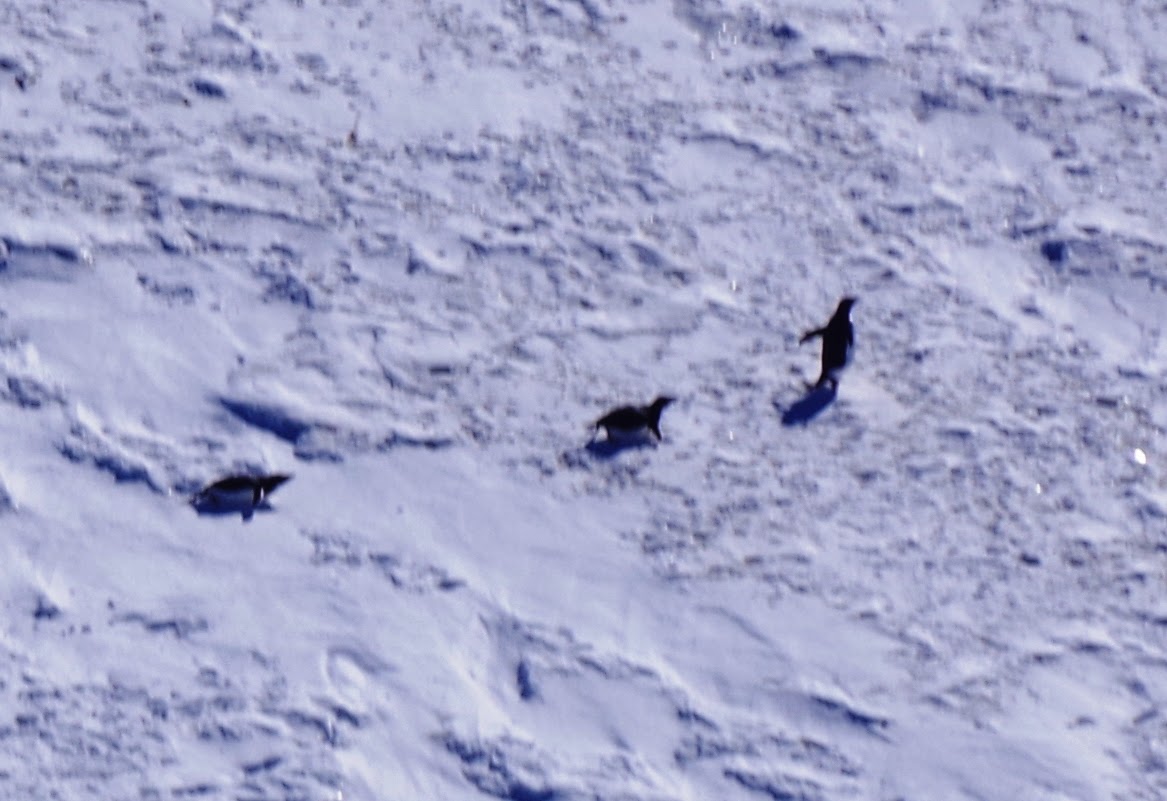 |
| Picture 1: Three adelie penguins on sea ice in McMurdo Sound. |
 |
| Picture 2: Three orca whales in McMurdo Sound. |
 |
| Picture 3: Wedell seal lounging on sea ice near Hut Point. |
I’ll start with the helicopter ride first. Adelie penguins tend
to use the ice edge as a staging ground since they feed off of krill and fish
in the surrounding waters (Picture 1). But why is there so much food for them to eat here? While
the sea ice is thick (up to 6 ft) it’s still thin enough to allow sunlight to
pass through. This allows the growth of primary producers (photosynthetic organisms) both algae in the ice itself and phytoplankton
in the area immediately below. The
waters of McMurdo Sound are rich in nutrients so the long hours of sunlight in
the summer months can really get the system going in terms of primary production (think of a garden growing with lots of light and fertilizer). As the
season progresses, the ice thins and melts causing the algae to fall out and
phytoplankton growth to rapidly increase. This phytoplankton is a main food source
for krill, small free swimming crustaceans, which form a significant portion of
the Adelie penguins’ diet.
Antarctic minke and orca whales are also present in these
waters (Picture 2). While the minke whales eat the plankton and krill, orcas are known to
eat penguins and fish. Therefore, they both tend to follow the ice edge as
well. While I had heard orcas can often be found in packs, I was still surprised to see so
many together. Overall, it made for a pretty eventful helicopter ride.
 |
| Picture 4: Emperor penguin near Hut Point in the process of molting. |
Back at McMurdo, we’ve seen a slow progression of different
marine mammals make their way to our area. Wedell seals have been present near
the base since I arrived in late December (Picture 3). They can hold their breath far
longer than penguins and therefore were seen much earlier in the season along
cracks, or pressure ridges, in the sea ice formed by internal stresses. Wedell
seals can eat a variety of marine organisms including krill, fish, squid and
sometimes even penguins.
 |
| Picture #5: Two adelie penguins near Hut Point. |
However, with the arrival of the coast guard icebreaker and
the subsequent arrival of a research vessel (the Palmer), there is now a decent
amount of open water near some portions of the coast line.
Unfortunately, the
area of ocean which has opened up is near an area has been off limits to us since
Monday morning due to all the activity at the docks associated with the soon to
be arriving resupply ship. Since I knew of this cutoff time in advance, I took
one last trip out to this area late Sunday night to see if there were any new
visitors to the area. I was pretty
surprised with what I found!
 |
| Picture 6: Wedell seal swimming near Hut Point. |
First, there was an emperor penguin not too far from the
shore (Picture 4). The Emperor actually showed up a couple of days earlier and has been
sitting patiently ever since. Emperor penguins are a little less common than adelies
in this area, but they sometimes follow the open water created by the
icebreaker. Emperor penguins are the
heaviest and tallest of all penguin species, sometimes reaching over 3 feet in
height. This particular emperor penguin is in the process of molting, or a
replacement of its feathers. Each year most penguin species will undergo this
process where old feathers which have become worn will be pushed out and replaced.
I’ve been impressed with how still this penguin has remained throughout the
days only moving to keep its back turned against the wind.
However, on this last trip I also found a couple of new
visitors to the area. Two adelie penguins had also made their way in along the
new pathway in the sea ice, though they appeared a little more tired from the
journey (Picture 5). By this time it was near midnight and I was pretty cold. I was about
to head back to the base when I saw something staring at me from the water. It turns out there was also a Wedell seal in
the area (Picture 6). This one seemed to be intrigued by me and stared at me a couple of
times while I stood watching.
 |
| Picture 7: Minke whale swimming near Hut Point. |